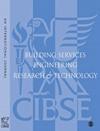Indoor occupancy estimation from carbon dioxide concentration using parameter estimation algorithms
IF 1.8
4区 工程技术
Q3 CONSTRUCTION & BUILDING TECHNOLOGY
Building Services Engineering Research & Technology
Pub Date : 2022-02-27
DOI:10.1177/01436244211060903
引用次数: 7
Abstract
The number of building occupants is an important indicator for predicting building energy consumption and developing control strategies for building automation. However, most occupancy estimation models were developed depending on the training steps where the true number of occupants is necessary. In order to calculate the occupant number independently, the newly-developed parameter estimation models were proposed, which are based on Maximum Likelihood (ML) approach and Bayesian analysis. A combination of multiple common measurements is used, including real-time CO2 concentration, energy consumption of facilities and make-up air system. The model starts by smoothing the raw CO2 concentration data using moving average, two-hour median as well as globally smooth. Then, ML and Bayesian analysis are used to establish the occupancy estimation models. The proposed models are evaluated in a commercial office which contains 36 occupants for validation. We find that the calculation errors could be reduced by using moving averaged data and globally smoothed data. The superiority of the parameter estimation models can be identified based on its lower calculation error and higher calculation accuracy compared to the previous established models. Practical Application Occupancy estimation models developed in this study are able to calculate occupant numbers independently and accurately in a non-intrusive way based on the indoor carbon dioxide concentration. This can provide input to a predictive building controller based on the application of occupancy estimation models. This could be applied to buildings across a district, informing demand-side management systems by employing occupancy behaviour and energy characteristics of individual buildings. This could allow both utility companies and building operators to simultaneously optimise their performance and benefit from this dedicated control strategy.基于参数估计算法的二氧化碳浓度室内占用率估计
建筑占用人数是预测建筑能耗和制定建筑自动化控制策略的重要指标。然而,大多数占用估计模型都是根据训练步骤开发的,其中需要真实的占用人数。为了独立计算乘客人数,提出了新开发的基于最大似然(ML)方法和贝叶斯分析的参数估计模型。使用多种常见测量的组合,包括实时CO2浓度、设施能耗和补充空气系统。该模型首先使用移动平均值、两小时中值以及全局平滑来平滑原始CO2浓度数据。然后,使用ML和贝叶斯分析建立了占用估计模型。所提出的模型在一个商业办公室中进行了评估,该办公室包含36名居住者以供验证。我们发现,使用移动平均数据和全局平滑数据可以减少计算误差。与先前建立的模型相比,参数估计模型的优越性可以基于其较低的计算误差和较高的计算精度来识别。本研究中开发的实际应用占用率估计模型能够根据室内二氧化碳浓度以非侵入性的方式独立准确地计算占用人数。这可以基于占用估计模型的应用向预测性建筑控制器提供输入。这可以应用于整个地区的建筑,通过采用单个建筑的占用行为和能源特征来为需求侧管理系统提供信息。这可以使公用事业公司和建筑运营商同时优化其性能,并从这一专用控制策略中受益。
本文章由计算机程序翻译,如有差异,请以英文原文为准。
求助全文
约1分钟内获得全文
求助全文
来源期刊

Building Services Engineering Research & Technology
工程技术-结构与建筑技术
CiteScore
4.30
自引率
5.90%
发文量
38
审稿时长
>12 weeks
期刊介绍:
Building Services Engineering Research & Technology is one of the foremost, international peer reviewed journals that publishes the highest quality original research relevant to today’s Built Environment. Published in conjunction with CIBSE, this impressive journal reports on the latest research providing you with an invaluable guide to recent developments in the field.
 求助内容:
求助内容: 应助结果提醒方式:
应助结果提醒方式:


